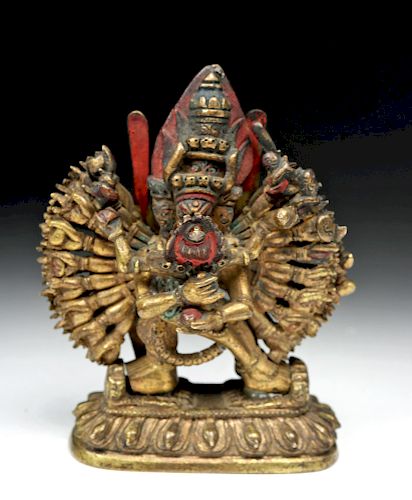18th C. Sino-Tibetan Gilt Bronze Yamantaka God
Lot 101
About Seller
Artemis Fine Arts
686 S Taylor Ave, Ste 106
Louisville, CO 80027
United States
Selling antiquities, ancient and ethnographic art online since 1993, Artemis Gallery specializes in Classical Antiquities (Egyptian, Greek, Roman, Near Eastern), Asian, Pre-Columbian, African / Tribal / Oceanographic art. Our extensive inventory includes pottery, stone, metal, wood, glass and textil...Read more
Estimate:
$1,200 - $1,800
Absentee vs Live bid
Two ways to bid:
- Leave a max absentee bid and the platform will bid on your behalf up to your maximum bid during the live auction.
- Bid live during the auction and your bids will be submitted real-time to the auctioneer.
Bid Increments
| Price | Bid Increment |
|---|---|
| $0 | $25 |
| $300 | $50 |
| $1,000 | $100 |
| $2,000 | $250 |
| $5,000 | $500 |
| $10,000 | $1,000 |
| $20,000 | $2,500 |
| $50,000 | $5,000 |
| $100,000 | $10,000 |
| $200,000 | $20,000 |
About Auction
By Artemis Fine Arts
May 10, 2018
Set Reminder
2018-05-10 10:00:00
2018-05-10 10:00:00
America/New_York
Bidsquare
Bidsquare : Fine Ethnographic / Asian / Ancient Art
https://www.bidsquare.com/auctions/artemis-gallery/fine-ethnographic-asian-ancient-art-3213
Featuring antiquities from around the world including Pre-Columbian, Tribal, Classical, Asian, so much more! Artemis Fine Arts info@artemisgallery.com
Featuring antiquities from around the world including Pre-Columbian, Tribal, Classical, Asian, so much more! Artemis Fine Arts info@artemisgallery.com
- Lot Description
Central Asia, Tibet, ca. 18th century CE. Cast via the lost wax (cire perdue) process, a gilded bronze statue depicting Yamantaka, a violent aspect of the Bodhisattva Manjushri, who takes on this phenotype in order to eliminate Yama, the god of death - assuming a dramatic pose upon a lotus pedestal. This piece depicts Yamantaka in a traditional manner, with 34 arms arranged in rows of 8 on each side, a snake between his legs, his main head that of a bull, wearing a crown of skulls, and engaged in a sexual position (yab-yum) with a consort. On the underside of the base is an impression of a lotus blossom. A superb example with nice remains of red cinnabar on the surface. Size: 3" H (7.6 cm) Size: 2.5" H (6.4 cm)
The name Yamantaka essentially translates to "The Terminator" derived from "Yama" meaning god of death and "Antaka" meaning terminator or destroyer in Sanskrit. Tibetan mythology tells of how one day Yamantaka climbed seven floors down into the earth toward hell in order to challenge the God of Death. Being strategic, Yamantaka assumed the frightening appearance of the God Yama. Upon seeing Yamantaka, the God of Death (Yama) was somewhat humorously "scared to death" of his own image.
Provenance: private Southern California, USA collection
All items legal to buy/sell under U.S. Statute covering cultural patrimony Code 2600, CHAPTER 14, and are guaranteed to be as described or your money back.
A Certificate of Authenticity will accompany all winning bids.
We ship worldwide and handle all shipping in-house for your convenience.
#130212Consort was cast separately and is removeable. Figure was reattached to the base, some visible adhesive at the juncture. Right set of arms is a bit loose but still attached. Otherwise, excellent with nice remains of red cinnabar on the gilded surface. Old inventory label and engraved floral makers mark on underside.Condition
- Shipping Info
-
All shipping is handled in-house for your convenience. Your invoice from Artemis Gallery will include shipping calculation instructions. If in doubt, please inquire BEFORE bidding for estimated shipping costs for individual items.
-
- Buyer's Premium



 EUR
EUR CAD
CAD AUD
AUD GBP
GBP MXN
MXN HKD
HKD CNY
CNY MYR
MYR SEK
SEK SGD
SGD CHF
CHF THB
THB

















